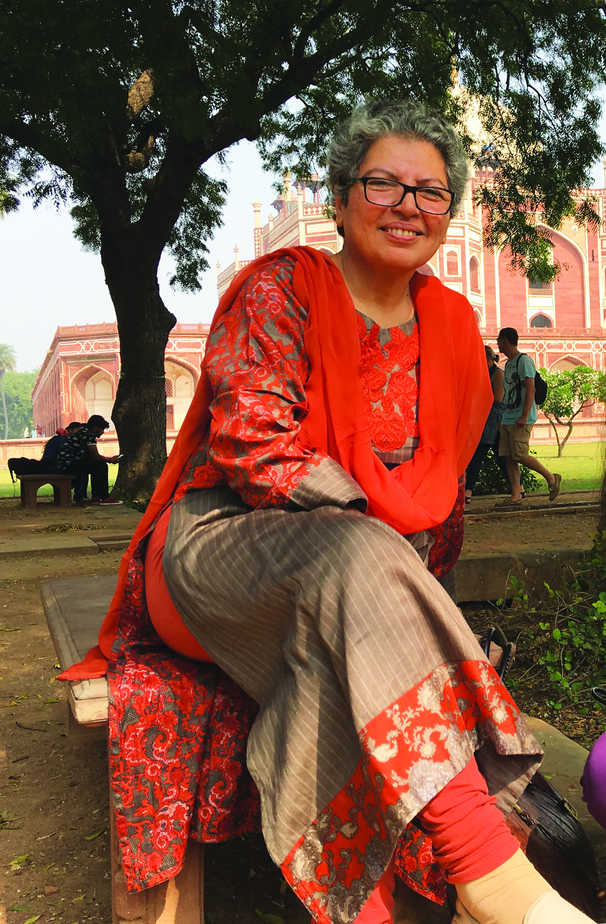Rana Safvi’s book The Forgotten Cities of Delhi is a reminder of our composite culture, manifested in art, music, culture and architecture of the past 1,500 years
An outsider is out to reveal the hidden secrets of Delhi, with much success and in quicktime. Rana Safvi’s association with Delhi started only in 2012, when she came visiting her daughter. She went for one of the heritage walks with Asif Khan Dehlvi, whom she remembers as a great repository of stories. She was fascinated by the city and read three books on Delhi to satisfy her curiosity, two of which were in Urdu, all of them more than a hundred years old. These books portrayed a Delhi that doesn’t exist anymore.
She developed a spiritual connect with the city that’s difficult to describe in words. A year later, in 2013, she came back for good and settled in a flat in Greater Noida. Her first book was on Mehrauli and the inspiration came from the Qutub Sahib’s dargah. “Qutub Sahib pulled me into Delhi,” she says and concurs that her Delhi connection has Sufi origins. She never looked back.
Her latest book, The Forgotten Cities of Delhi, the second of the trilogy she plans on Delhi, talks about the 14 cities that flourished in Delhi, now in ruins, almost hidden in the concrete jungle we know. The characters of this books are the monuments. Since her childhood, Safvi has been fascinated by “ruins”. “I felt every stone has a story to tell me in my fanciful imagination. So many stories are hidden in these ruins,” she says. For sure, crumbling buildings from the past are mute witness to history, age gives them a certain character.
A prolific writer and blogger, Safvi started writing only when she turned 55 years of age, which coincides with her coming to Delhi. It was almost like a new life. “I started late and have to make up for the lost years,” she says, sipping cold coffee in an upmarket cafe. She calls Delhi her ‘karmabhumi’ though she’s a Lucknow girl, and has a little library in her Greater Noida apartment, where she lives with her father-in-law and daughter. Researching and writing has become integral to her life in Delhi, she does it three days of a week, religiously. Her husband, Gazanfar, is an NRI who visits regularly. Before settling down in Delhi, she lived for 15 years in Saudi Arabia, Oman, and Dubai and was a teacher.
The Forgotten Cities of Delhi covers 1,500 years in the life of Delhi, demolishes some popular myths in light of facts and is a must for those who want to know understand the complex city. For instance, Delhi moved south to north as it developed, shifting from Mehrauli towards Shahjahanabad. So, mind it, Delhi-6 is not the old Delhi, but is fairly recent, and south Delhi is actually the oldest part. The Lodhi and the Khilji dynasties were responsible for the culmination of Islamic geometric art with that of Indian motifs. The most commonly used motives were lotus (which is the party symbol of the BJP) and ‘kalash’ or the earthen pot. Khiljis and Lodis started the Indo-Persian style of architecture that was perfected by the Mughals.
The Lodis were prolific builders; three of the dynasty’s rulers build some 100 tombs. Tombs were available to those who could buy them, not just a privilege of the ruling class. Due to an abrupt end of the dynasty, many of the tombs have no one buried in them. Lodi Garden, where the rich and mighty go walking, was called the Bagh-e-Jadd for a long time, was actually an enormous burial ground that extended up till Chirag Delhi. Jorbagh was actually ‘Joru-ka-bagh’ or wife’s garden, as it was the estate of Nawab Qudsia Begum, wife of emperor Mohammad Shah (1717-48 AD). That’s what her research shows, though some historians don’t agree.
By early nineteenth century, Delhi was a city of ruins, as described by English traveller and the Bishop of Calcutta, Bishop Heber, ‘awful scenes of desolation, ruins after ruins, tombs after tombs…scattered over a soil naturally rocky and barren, without cultivation, except in one or two small spots, and without a single tree.’ Unlike popular belief, it was not the Mughals, but the English who destroyed many of the monuments. Mughal architecture was actually a victim. In the early twentieth century, Lutyens Delhi was built on the ruins of Lodi edifices, confirms Safvi, that include tombs, graves, pavilions, well and mansions. Railway lines in Delhi were laid demolishing the hundreds of structures, like the tomb of Zeb-un-Nisa who was a daughter of Aurangzeb. “It’s a great pity that in the aftermath of the 1857 uprising, lot of our national treasure was taken to the museums of the West, particularly Britain. Now if one has to study about Delhi, has to depend on western archives and sources,” Safvi says with a sense of irony.
Many of the professional historians in the academic world remind her that she isn’t qualified enough to channelize her passion into writing. “Because I’m not a PhD,” she says. Shamsur Rahman Faruqui, renowned poet and Urdu critic, advised her there’s no need for a PhD for writing books. “A book is like a PhD thesis,” she says and smiles. She’s a popular online figure, her blogs don’t just talk about monuments, but Sufism, music and cuisine. She highlights Ganga-Jamuni tehzeeb, composite culture. She is trolled on social networking sites because she talks of peace and coexistence amongst communities.
Undeterred, Safvi continues to document her fascination and love for the city of Delhi. It’s not easy, mostly she’s alone, trying to reach every nook and corner, to rediscover hidden jewels of the past, in ruins. She’s working on three books, regularly contributes to the leading dailies and news portals. Her insatiable urge to rediscover Delhi’s past will play an important role in shaping its future.





